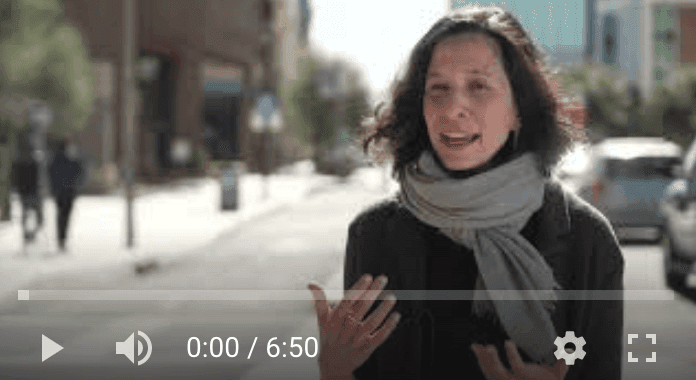
News
By Helen Hope, Smart Growth America, February 22, 2022
Our newest video tells the story of how Tucson’s community is building both advocacy for and physical implementations of Complete Streets while putting equity at the center of the work.
“The value of streets is…public space, but not just a way to get from A to B…Complete Streets is not just about efficient transportation, but also about cultivating the type of place where people are out and about connecting to each other.”
– Evren Sönmez, Living Streets Alliance
Tucson’s story
Inhabited for more than five thousand years, Tucson is looking towards its future. Each year, close to 4,000 Tucsonans are injured—and more than 50 people lose their lives—while traveling on city streets. Sidewalks are missing, bike lanes are unfinished, and streets have been designed for years to encourage speed over safety in the city. As Tucson Mayor Regina Romero says, “In Tucson, we have not created a safe route for bicyclists and pedestrians.”
The Tucson Mayor and Council unanimously adopted a strong Complete Streets policy in 2019 after three years of advocacy by local groups, including the Living Streets Alliance who advocate for public policies and funding that ensure the safe and dignified movement of all Tucsonans. The policy gave birth to a new Complete Streets Coordinator position, filled by Patrick Hartley, to ensure prioritization in underinvested areas with a holistic approach to equity, public health, and safe mobility options for all.
About these videos
With the support and partnership of CityHealth, we have been profiling cities with exemplary Complete Streets policies. Over the last two weeks, we released a video about Pittsburgh, PA and a second story about Louisville, KY.
Complete Streets are streets for everyone—designed and managed to prioritize safety, comfort, and access to destinations for all people who need to use a street. Complete Streets policies can help cities transform how they make decisions about their streets. Done right, these policies can help cities improve public health and address longstanding inequities in the transportation system. The National Complete Streets Coalition at Smart Growth America has been advancing the adoption and implementation of Complete Streets policies for two decades to ensure that everyone who needs to use our streets—no matter how they get around—can safely and comfortably do so.
CityHealth and the National Complete Streets Coalition at Smart Growth America recognize cities with exemplary Complete Streets policies—a key step in producing safer streets that can be used by everyone. Learn more at cityhealth.org and completestreets.org.
Equalizing health disparities
“Complete Streets is more about a philosophy or an approach, and putting equity at the centerpiece of it…is a critical tenet of that…we can’t think about Complete Streets without thinking about disparities and equity issues that come with that.”
– Evren Sönmez from the Living Streets Alliance
It’s no secret that improvements in the built environment that make walking and biking more accessible can reduce health disparities. Prevention of chronic diseases, reduction and prevention of vehicle-related injuries and death, and improved environmental health are all effects of increased availability of transportation options. These disparities are one of the reasons Tucson is implementing Complete Streets policies.
“When I talk about Complete Streets, I talk about health in general, right? Disproportionately, Mexican-Americans, African-Americans, and Native are affected with diabetes. That’s a huge burden on some communities” says Grecia Ramirez, a resident in the Tucson community.
The Complete Streets program in Tucson is focused on improving equity by identifying locations where residents are more dependent on walking, biking, and taking transit as their primary means of transportation, and prioritizing changes in those areas first. And because these locations historically have seen lower levels of investment, “they’re gonna face those risks at higher levels than somebody who’s just getting in their car and going from Point A to point B,” as said by Hartley.
Looking to the future
“My vision for the next 10, 20, 30 years for Tucson is definitely to institutionalize the concept of Complete Streets and mobility. It’s where we have to go.”
– Regina Romero, Mayor of Tucson, Arizona
In Tucson, the focus on the institutionalization of complete streets and mobility should be poised to answer the question: what do you want the city to look like in 20 or 30 years? For current and future residents — like the Ramirez’s child in the video — the work being done now will allow Tucson to be a place where all residents want to stay and live, and have healthy options to do so. Hopefully it will instill the idea that the city is not just for cars, “that it’s also about the people who are walking and the people who are on bicycles, the people who are in wheelchairs, the people who get on and off of buses.”
Now, the city is moving a Parks and Connections Bond forward to create “hundreds of miles of bike boulevards” and pedestrian pathways, including missing sidewalks like the ones Jennifer Flores alludes to in the video outside of the school where she teaches. Low-cost solutions to other problems are being implemented during re-striping of streets: creating narrower lanes of traffic, installing buffers between different modes of lanes. With the bond generating $225 million over nine years, not only is there community buy-in, but government financial buy-in as well. As Mayor Romero says, they have a long way to go in Tucson, but investments like these will help Tucson put the philosophy of Complete Streets in motion.
“If we were in the position to not have a car, I think that would be ideal…The choice is really important.”
– Antonio Ramirez
Read the full transcript (PDF)
Don’t miss the other Complete Streets videos
Watch Pittsburgh’s video. Watch Louisville’s video.
Follow us on social for more: @smartgrowthusa / @completestreets / @city_health
Watch more videos from The Living Streets Alliance about Complete Streets in Tucson.
Related News

© 2025 Smart Growth America. All rights reserved
Site By3Lane Marketing






















